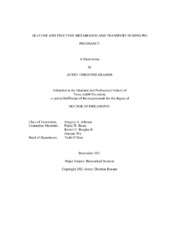| dc.description.abstract | The swine industry experiences high rates of embryonic/fetal loss and there is
considerable variation of birthweight between piglets within a litter. These outcomes
negatively impact the swine industry’s overall efficiency and profitably. It is hypothesized
that insufficient placental development and endometrial support during pregnancy are
direct causes of the high rates of embryonic/fetal loss within this industry. This study
examined how glucose and fructose are transported and metabolized at the uterine
placental interface to support growth and development of the placenta and embryo/fetus.
Conceptuses from day 16 of pregnancy were incubated with either ¹⁴C-glucose or
¹⁴C-frucose and amounts of radiolabeled CO₂ released from the conceptuses were
measured to determine the oxidation rates of glucose and fructose. Glucose and fructose
were both actively metabolized by the conceptuses, with glucose being metabolized to a
greater extend then fructose in that in the presence of glucose and fructose, glucose was
preferentially metabolized over fructose. Endometrial and placental expression for the
glucose transporters SLC2A1, SLC2A2, SLC2A3, and SLC2A4 were determined. SLC2A1
mRNA and protein was the most abundant glucose transporter in the endometrium and
expressed in the uterine luminal epithelium (LE) of pregnant gilts compared to cyclic gilts.
SLC2A4 mRNA was also expressed in the uterine LE of pregnant gilts. On day 15 of
pregnancy, the conceptus trophectoderm weakly expressed SLC2A2 mRNA, while
SLC2A3 mRNA was abundant in the trophectoderm/chorion throughout pregnancy.
Proliferating and migrating cells switch metabolism from oxidative
phosphorylation to aerobic glycolysis to enhance the production of glycolytic
intermediates for utilization of the branching pathways of glycolysis. One of the branching
pathways of glycolysis is the Pentose Phosphate Pathway (PPP). Lactate concentrations
with in the uterine lumen increase from day 13 to 15 and 17 of pregnancy. Conceptus
trophectoderm cells express the enzyme G6PDH mRNA and protein, with highest levels
of mRNA and protein on days 13 and 15 of pregnancy, respectively, G6PDH protein then
decreases sharply on day 16 of pregnancy. Carbons derived from glucose, but not fructose
entered into the PPP with maximum levels of utilization on day 15 of pregnancy. These
results establish the molecular components for hexose sugar transport from the maternal
vasculature and into conceptus tissues, glucose and fructose can be directly metabolized
by conceptus trophectoderm cells, and conceptus trophectoderm cells metabolize glucose
via the pentose phosphate pathway. | |


